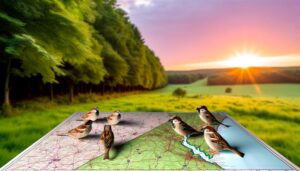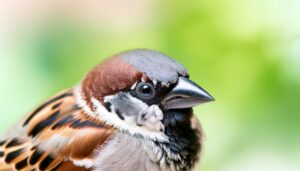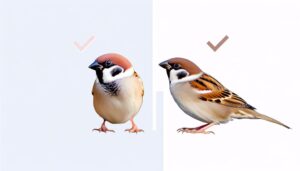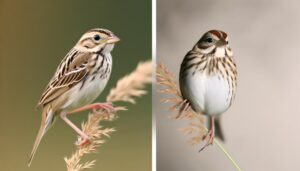3 Common Sparrows You Can Spot in Wisconsin
Wisconsin's biodiversity flourishes with various distinctive sparrow species, including the Song Sparrow, Chipping Sparrow, White-throated Sparrow, American Tree Sparrow, and Fox Sparrow. Each species, identifiable through unique markings and behaviors, thrives in environments from urban areas to farmlands and forests.
Their diets typically consist of seeds, insects, and berries. Sparrows not only have a significant impact on the ecosystem but also face threats due to habitat loss.
Essential conservation efforts focus on habitat preservation and population monitoring. By forging ahead, one may glean insights into the fascinating aspects of Wisconsin's common sparrows, such as species-specific traits, habitats, and conservation initiatives.
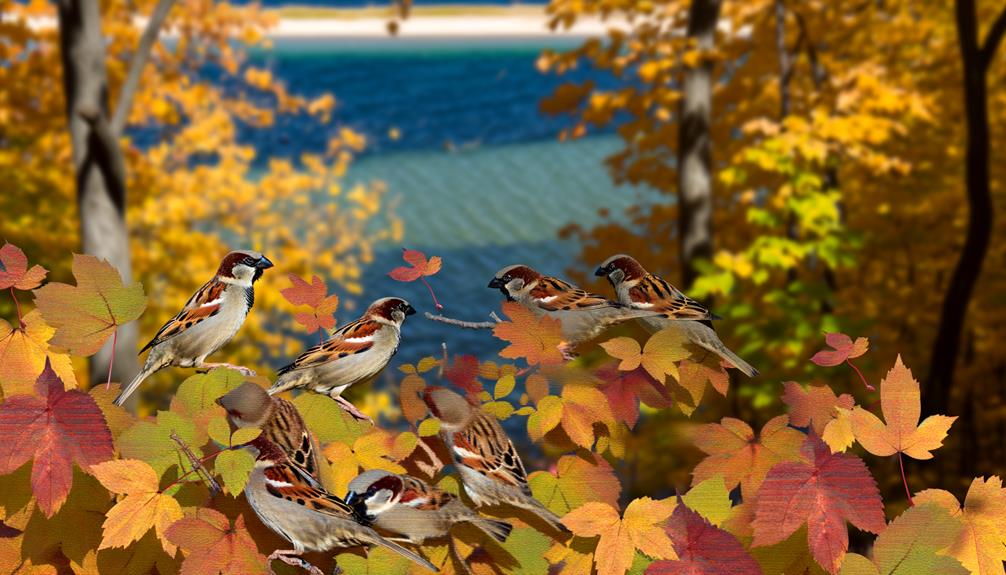
Key Takeaways
- Common sparrows in Wisconsin include Song Sparrow, Chipping Sparrow, White-throated Sparrow, American Tree Sparrow, and Fox Sparrow.
- These sparrows thrive in diverse environments such as urban areas, farmlands, forests, and marshes.
- Sparrows in Wisconsin primarily feed on seeds, insects, and berries, adjusting their diet according to the season.
- Sparrows are easily identifiable through their size, shape, plumage patterns, and distinct songs.
- Major threats to Wisconsin's sparrow population are habitat loss, predation, and climate change effects.
Understanding Sparrows: Definition and Characteristics
Unassumingly, sparrows, often recognized by their small size, stout bodies, and short tails, are a diverse group of birds that exhibit a variety of unique characteristics and adaptations suited for their specific habitats.
Their beaks, for instance, are conical and robust, designed for seed-eating. They're also known for their drab yet beautiful plumage, which often varies from browns, grays, and whites, providing excellent camouflage against predators.
Additionally, sparrows display a remarkable ability to adapt to urban environments, often nesting in man-made structures. Their songs, while not as melodious as other birds, have a charm of their own.
Scientifically, sparrows belong to the family Passeridae and are primarily found in the Old World, although they've successfully colonized diverse regions globally.
Sparrow Species Overview
In the rich avian tapestry of Wisconsin, various sparrow species make a significant presence. Each species, with distinctive markings, behaviors, and habitats, not only contributes to the biodiversity but also plays a unique role in the ecosystem.
A thorough understanding of these species alongside their habitats, diets, and the ongoing conservation efforts is vital to secure their continued survival and prosperity.
Identifying Sparrow Varieties
Wisconsin's birdwatchers often find themselves marveling at the diverse variety of sparrow species, each with distinct features and behaviors that set them apart.
The Song Sparrow, for instance, is recognizable by its streaked brown plumage and distinctive melody.
The Chipping Sparrow, on the other hand, dons a rufous cap during breeding season, making it easy to spot.
The White-throated Sparrow stands out with its striking white bib, while the American Tree Sparrow sports a bi-colored bill and a chest spot.
The Fox Sparrow, with its bold, thick streaks and foxy red coloration, is a favorite among enthusiasts.
Sparrow Habitats and Diets
Birdwatchers keen on understanding sparrows more deeply should certainly look into their habitats and diets, as these elements play a significant role in the distinct behaviors and survival strategies of these species.
Sparrows thrive in diverse environments, from urban areas to farmlands, forests, and marshes. Their diet primarily consists of seeds, but they're also known to consume small insects and berries.
Consider the table below:
| Sparrow Species | Preferred Habitat | Common Diet |
|---|---|---|
| American Tree Sparrow | Brushy areas, forest edges | Seeds, insects |
| Chipping Sparrow | Open woodlands, parks | Insects, seeds |
| House Sparrow | Urban and suburban areas | Seeds, grains, insects |
Understanding these characteristics not only enriches one's birdwatching experience, but also aids in distinguishing between the species. Importantly, habitat and diet can vary greatly among sparrows, emphasizing the adaptability of these resilient birds.
Sparrow Conservation Efforts
Despite their common presence, several sparrow species face significant conservation challenges, necessitating ongoing efforts to protect and sustain their populations.
In Wisconsin, habitat loss from urban development and farming practices are major threats. Conservationists are focusing on preserving habitats, especially grasslands, crucial for sparrow nesting and feeding. They're also monitoring populations to track any decline.
Additionally, programs are established to educate the public about the importance of these birds in maintaining ecological balance. They're encouraged to install birdhouses and feeders, creating safe spaces for sparrows.
Pesticide use is another concern, as it's harmful to sparrows' food sources. Thus, promoting organic farming is a part of the conservation strategy. These efforts aim to guarantee the survival of Wisconsin's sparrow populations.
The American Tree Sparrow
The American Tree Sparrow, a prevalent species in Wisconsin, is known for its unique features and adaptability. Remarkably, it adjusts well to Wisconsin's cold winters.
An identifying characteristic is its bicolored bill, with the upper mandible being dark and the lower yellow. It's slightly larger than other sparrow species, averaging about 6.3 inches in length.
Scientifically classified as Spizelloides arborea, this sparrow is omnivorous, consuming both plant matter and insects. Its diet fluctuates seasonally; seeds and grains dominate in colder months, while insects are favored in warmer times.
The American Tree Sparrow's mating system is monogamous, with both parents taking part in nurturing their offspring. Understanding these traits aids in appreciating the role this bird plays in Wisconsin's ecosystem.
Chipping Sparrow: A Closer Look
Turning our focus to the Chipping Sparrow, this bird's distinct features, such as its rusty cap and black eye-line, make it easily identifiable.
We'll examine its habitat and migration patterns, noting its preference for open woodlands and its significant journey from northern Canada to southern United States and Mexico.
An exploration of its diet and feeding habits will also provide insight into its preference for seeds, insects, and occasionally, fruits.
Chipping Sparrow's Distinct Features
Sporting a crisp, clean look with a sharp cap of rust-red, the Chipping Sparrow is easily recognized in Wisconsin's bird community. Its underparts are pale and its back is brown with dark streaks, creating a beautiful contrast. The bird's beak is black in the summer and yellow-brown in winter, a distinguishing feature that sets it apart.
To evoke emotion and provide more detailed understanding, let's look at the table below:
| Feature | Description | Emotional Impact |
|---|---|---|
| Rust-red cap | Sharp and distinct | Instills a sense of uniqueness |
| Pale underparts | Contrast with dark back | Evokes a feeling of balance |
| Seasonal beak | Changes color with season | Inspires fascination with nature |
These distinct features make the Chipping Sparrow a captivating subject of study for bird watchers and nature enthusiasts alike.
Habitat and Migration Patterns
Abundant in Wisconsin's diverse landscapes, Chipping Sparrows exhibit fascinating migration patterns, typically nesting in open woodland habitats during the summer and migrating to the southern United States and Mexico when winter approaches.
These sparrows are well-adapted to the deciduous forests and mixed woodlands, where they often utilize shrubs and edge habitats for nesting.
Their migration, a remarkable biannual journey, is driven by the need for food and warmer climates. During this time, they form large flocks and travel in daylight, a rare phenomenon among sparrows.
Upon arrival in their wintering grounds, they mostly inhabit weedy fields, gardens, and parks. Understanding these patterns is critical, as changes in climate and habitat loss may impact their migratory routes and survival.
Diet and Feeding Habits
Delving into the dietary habits of the Chipping Sparrow, it's clear that this bird's diet primarily consists of seeds and insects, with a distinct preference for the latter during the breeding season. This dietary shift allows them to provide protein-rich food to their offspring, enhancing their growth and development.
The Chipping Sparrow's feeding technique is worth noting. They forage on the ground, utilizing a 'double-scratch' technique where they hop forward and back quickly, scratching the ground with both feet to uncover food.
| Feeding Technique | Food Source |
|---|---|
| Ground Foraging | Insects |
| Ground Foraging | Seeds |
Life of the Field Sparrow
The Field Sparrow's existence in Wisconsin, marked by its distinctive, clear whistling song, provides an interesting glimpse into the avian biodiversity of the region. Scientifically known as Spizella pusilla, this species has a unique life cycle and behaviors that contribute to its intriguing survival.
- Its lifespan typically ranges from 3 to 5 years, although the oldest recorded Field Sparrow survived for 8 years and 10 months.
- Field Sparrows breed from mid-May to early August, with their nests usually situated close to the ground in shrubs or grass tufts.
- They primarily feed on seeds and insects, adapting their diet based on seasonal availability.
- Their migratory patterns are typically short-distance, with most wintering in the southern United States.
- Field Sparrows are known for their resilience, surviving harsh conditions, and adapting to changing environments.
This bird's remarkable adaptation and survival strategies make it an intriguing subject of study.
The Distinct Song Sparrow
The Distinct Song Sparrow is a common species in Wisconsin. It demonstrates unique physical and behavioral features. An analytical understanding of its song patterns provides insight into its communication strategies and breeding habits.
Additionally, its habitat preferences shed light on the species' adaptability and the ecological factors influencing its distribution.
Song Sparrow's Unique Features
With its streaked brown plumage that's often mistaken for other species, the Song Sparrow holds a unique distinction among Wisconsin's common sparrows. Its scientific name, Melospiza melodia, indicates its melodic song, a characteristic trait that sets it apart from its feathered peers. But the differences don't end there.
The Song Sparrow's unique features include:
- A long, rounded tail that often twitches when singing.
- A distinctive central chest spot, darker than the rest of its streaked underparts.
- A robust bill, adapted for cracking seeds.
- The presence of a malar stripe, or 'moustache', a unique facial marking.
- Its song, a series of notes followed by a trill.
These distinctive features, combined with a broad diet and adaptable nature, make the Song Sparrow an essential part of Wisconsin's diverse avian ecology.
Understanding Sparrow Song Patterns
Shifting our attention to the Song Sparrow's vocal traits, it's intriguing to note that their melodic tunes aren't just pleasant to the ear but also serve as a distinct communication system.
These patterns, often referred to as 'song bouts', are intricate and complex. Each bout typically consists of several elements or notes, arranged in a unique sequence, which is repeated several times. The repetition aids in the identification of the song by the listener.
There's a significant variance in the pattern and complexity of song bouts across different Song Sparrow populations. Studies suggest that the complexity of the song bouts is directly related to the male sparrow's age and experience, implying a learning process that's fascinating to ponder.
Song Sparrow's Habitat Preferences
Nestled within the dense undergrowth or perched on low shrubs, Song Sparrows display a preference for thickly vegetated habitats, a choice that's as distinct as their complex song bouts. These environments provide the necessary cover and resources for their survival and breeding.
To further understand their habitat selection, consider the following:
- They favor areas with dense, low vegetation, offering protection from predators.
- Proximity to water bodies is preferred for easy access to hydration and bathing.
- Brush piles, hedgerows, and thickets are often chosen for nesting.
- Open areas for foraging, where they can find a variety of insects and seeds, are essential.
- An ample supply of twigs and leaves is important for nest building.
These preferences illustrate how Song Sparrows have adapted to thrive in specific environments. Understanding these can aid in their conservation efforts.
Exploring the Savannah Sparrow
Wisconsin's extensive grasslands are the favored habitat of the Savannah Sparrow, a common species distinguished by its brief, indented tail and brown-streaked upperparts. They are skilled at taking advantage of grassland ecosystems and have adjusted to various environments, from coastal marshes to alpine meadows.
The table below shows key characteristics of the Savannah Sparrow:
| Characteristic | Description | Importance |
|---|---|---|
| Plumage | Brown-streaked upperparts | Disguise in grasslands |
| Tail | Brief, indented | Assists in nimble flight |
| Habitat | Grasslands | Abundance of insects for nourishment |
The Savannah Sparrow is a fascinating study of adaptation and survival. Its plumage offers superb disguise against predators, while its brief, indented tail aids nimble flight in the thick grasslands. Its lifestyle is a tribute to the enduring resilience and adaptability of nature, making it a significant player in Wisconsin's diverse avian ecosystem.
The White-Throated Sparrow
Have you ever encountered the White-Throated Sparrow, a common bird species in Wisconsin known for its strikingly beautiful white bib and melodious song?
This bird is a captivating study for both ornithologists and bird enthusiasts alike. Here are some intriguing characteristics of the White-Throated Sparrow:
- Its Latin name, Zonotrichia albicollis, literally translates to 'white-throated' and 'banded hair', reflecting its distinctive markings.
- It's primarily granivorous, relying heavily on seeds and grains for sustenance.
- The species exhibits a unique form of plumage polymorphism, with two distinct color morphs.
- Males and females look alike, making sex differentiation challenging.
- The bird's song has been described as a poignant, whistled phrase, 'Oh sweet Canada, Canada, Canada.'
Fascinating Facts About the Fox Sparrow
Remarkably, the Fox Sparrow, with its vivid rufous plumage and hefty size, stands out among the common sparrow species in Wisconsin. This robust bird, scientifically known as Passerella iliaca, exhibits a fascinating geographic variation.
It's divided into four primary groups: Red, Sooty, Slate-colored, and Thick-billed, each with unique coloration and song patterns. Adept at foraging, it uses a distinct two-footed, backward-scratching technique to uncover food, leaving a noticeable 'double-kick' impression in the soil. Its diet primarily consists of seeds, berries, and insects.
Additionally, the Fox Sparrow's song, a rich, melodious whistle, is a remarkable feature that distinguishes it from other sparrows. These distinctive traits contribute to the Fox Sparrow's unique appeal among birdwatchers and ornithologists alike.
Sparrows' Ecological Importance
Sparrows, as humble and commonplace as they might seem, play a pivotal role in maintaining ecological balance in their habitats. Their presence, often overlooked, is an essential cog in the wheel of environmental equilibrium.
Here's why:
- Sparrows control insect populations. They're voracious insectivores, preying on pests that can wreak havoc on vegetation.
- They contribute to seed dispersion. Feasting on seeds, they inadvertently scatter them, assisting in plant propagation.
- They serve as food for larger predators, maintaining predator-prey balance.
- Their nests provide habitats for other creatures, creating biodiversity.
- Sparrows indicate environmental health. Changes in their population can signal ecological shifts.
Understanding sparrows' ecological importance brings a newfound respect for these tiny titans of the ecosystem. They aren't just common birds; they're ecological linchpins.
Tips for Sparrow Identification
Identifying these seemingly indistinguishable birds might seem challenging, but with a keen eye and some basic knowledge, one can easily distinguish between different species of sparrows. Size and shape offer the first clues. For instance, the Song Sparrow's robust, rounded shape contrasts with the slender, elongated form of the Grasshopper Sparrow.
Plumage patterns also provide important cues. The white throat patch of the White-throated Sparrow is a clear identifier, while the Fox Sparrow's distinctive rufous coloration sets it apart. Behavior, too, can guide identification. The Chipping Sparrow, for example, is known for its incessant, trilling song.
Best Spots to Observe Sparrows in Wisconsin
Now that we've equipped you with identification tips, let's explore the top locales in Wisconsin where you're likely to spot these fascinating sparrows. Wisconsin's diverse habitats offer excellent bird-watching opportunities. Here are the prime locations:
- Horicon Marsh: As the largest freshwater cattail marsh in the U.S, it's a haven for sparrows, especially during migration seasons.
- Bay Beach Wildlife Sanctuary: With its 600 acres of urban wildlife refuge, it's perfect for spotting a variety of sparrow species.
- Schlitz Audubon Nature Center: A diverse habitat that supports both resident and migrating sparrows.
- Governor Nelson State Park: With its open grassland, it's ideal for sparrows like the Grasshopper Sparrow.
- Devil's Lake State Park: Its 9000 acres provide a diverse ecosystem attracting numerous sparrow species.
Each location offers unique opportunities for observing sparrows in their natural habitats.
Protecting Wisconsin's Sparrow Population
Despite their abundance, Wisconsin's sparrow population faces significant threats, necessitating concerted efforts for their conservation and habitat protection. The primary threat is habitat loss, caused by urban development and agricultural expansion. These factors degrade the sparrows' natural environment, leading to a decrease in their food sources and nesting sites.
Other threats include predation by cats and other invasive species, and climate change, which can alter the sparrows' migratory patterns and breeding seasons. In light of this, protective measures should focus on preserving and restoring the sparrows' habitats, implementing responsible pet ownership, and mitigating the effects of climate change.
Public education about the sparrows' ecological role and the consequences of their decline is also essential to foster a supportive community for their conservation.
Conclusion
Ironically, these seemingly unremarkable sparrows, often overlooked, play an essential role in Wisconsin's ecosystem. Their constant foraging helps control insect populations, and their nests support local plant life.
Despite their ordinary appearance, identifying them requires a sharp eye and patience. So, next time you're in Wisconsin, take a moment to appreciate these unsung heroes.
After all, preserving our environment means protecting even the smallest members, like the modest, yet vital, sparrow.

